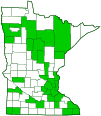northern crab spider
(Mecaphesa asperata)
Conservation • Description • Habitat • Biology • Distribution • Taxonomy
|
|
||||||||||||||
Description |
Northern crab spider is a small spider. It occurs in the United States, southern Canada, and Mexico. In the United States it is common to very common in east, less common in the west. It is found on grasses, flowers, and foliage in meadows, fields, roadsides, and gardens. It is one of several spiders called “flower spiders” because it waits in ambush in flowers often for hours at a time. The female is ¼″ (6 to 7 mm) in length and has a legspan of up to ½″ (12 mm). It is hairy and there are numerous spines and bristles on the body and legs. The plate (carapace) covering the front part of the body (cephalothorax) is flat and as long as wide. It is brownish-yellow to pale green with two dull, reddish-brown, longitudinal stripes. It is covered with scattered, erect, black hairs of varying length and thickness. The male is much smaller, ⅛″ (3.5 to 4 mm) in length with a legspan of ¼″ (6 mm) or more. There are eight eyes arranged in two curved rows of four. All of the eyes are on low raised projections (tubercles). In the front row the outermost eyes, the anterior lateral eyes (ALE), are a little larger than the interior eyes, the anterior median eyes (AME). In the back row the posterior lateral eyes (PLE) are directed sideways and backwards. They are not visible when the spider is viewed from the front. The jaws (chelicerae) are small and have no teeth. The abdomen is flat, broadly oval, and widest near the rear. It is often yellow with reddish-brown markings, but the background color can change to white or pale green to blend in with the vegetation. On the front half of the abdomen there is a central stripe and two lateral stripes. On the back half, behind the central stripe, there are two rows of closely-spaced spots converging at the rear of the abdomen and forming a capped V shape. The legs are pale with pinkish or reddish bands on the fifth segment (tibia) and the sixth segment (metatarsus). The front two pairs of legs are thicker and much longer than the others, and are normally held out and forward, like a crab. This is the feature that gives the family Thomisidae its common name. There is a pair of minute claws at the end of the legs but these are not visible without magnification. |
Size |
Female Body Length: ¼″ (6 to 7 mm) Male Body Length: ⅛″ (3.5 to 4 mm) Legspan: ¼″ to ½″ (6 to 12 mm) |
Web |
No web |
Similar Species |
Habitat |
Meadows, fields, roadsides, and gardens |
Biology |
Season |
|
Behavior |
When the legs are held out to the side, the spider is able to walk forward, backward, or sideways (laterigrade). When hunting, the spider will sit, often in a flower and often for hours, waiting in ambush for prey. The female does not build webs, snares, or retreats. To protect its egg sac it will fold over the edge of a leaf and secure it with silk. |
Life Cycle |
The male is tiny compared to the female. To mate without first being eaten, it must first tie up the female with silk. After mating, the female easily breaks the restraints. |
Food |
|
Distribution |
||
|
Sources |
|
| 4/27/2024 | ||
Occurrence |
||
Common |
||
Taxonomy |
|
Class |
|
Order |
|
Suborder |
Araneomorphae (Typical Spiders) |
Infraorder |
Entelegynae |
Zoosection |
RTA clade (RTA Clade Spiders) |
Zoosubsection |
Dionycha clade spiders |
Family |
Thomisidae (crab spiders) |
Tribe |
Misumenini |
Genus |
|
Genus Higher taxa A later phylogenetic analysis of the order Araneae (Wheeler et al., 2017) presented a new spider tree of life based on mitochondrial and nuclear genomes. The number and arrangement of the ranks and clades between the Order Aranae and the Family Thomisidae vary depending on the source. The superfamily Thomisoidea is eliminated. Araneomorphae is treated as an suborder by some sources, some rank Opisthothelae as the suborder and Araneomorphae as the infraorder, and some have Araneomorphae as the infraorder and no suborder. Opisthothelae is sometimes treated as an unranked clade, but it is more often omitted entirely. Most treat Entelegynae as an unranked clade, with two more unranked clades above (basal to) the Family Thomisidae. Some or all unranked clades are often omitted from taxonomic trees. The ranking on this page follows iNaturalist. |
|
Subordinate Taxa |
|
|
|
Synonyms |
|
Misumenops asperatus |
|
Common Names |
|
northern crab spider northern flower crab spider |
|
Glossary
Carapace
The hard, upper (dorsal), shell-like covering (exoskeleton) of the body or at least the thorax of many arthropods and of turtles and tortoises. On crustaceans, it covers the cephalothorax. On spiders, the top of the cephalothorax made from a series of fused sclerites.
Cephalothorax
The front part of a spider’s body, composed of the head region and the thoracic area fused together. Eyes, legs, and antennae are attached to this part.
Chelicerae
The pair of stout mouthparts, corresponding to jaws, in arachnids and other arthropods in the subphylum Chelicerata.
Tibia
The fourth segment of an insect leg, after the femur and before the tarsus (foot). The fifth segment of a spider leg or palp. Plural: tibiae.
Tubercle
On plants and animals: a small, rounded, raised projection on the surface. On insects and spiders: a low, small, usually rounded, knob-like projection. On slugs: raised areas of skin between grooves covering the body.
Visitor Photos |
||
Share your photo of this arachnid. |
||
This button not working for you? |
||
Dan W. Andree |
||
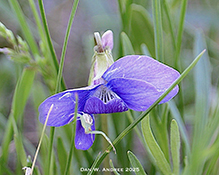 |
||
Northern Crab Spider on a Prairie Violet... It looks more like an illustration than a photo. It's that little crab spider that was hiding behind the blossom and when I touched the blossom it thought I was an insect or something for lunch until it realized it was a bit tooo big. It then scooted back behind the prairie violet blossom. Eventually came out. Funny little spider. |
||
I became acquainted with the Jackal Flies... I seen a northern crab spider on a blanket flower it had an insect caught and feeding on it when a few small flies showed up, then more and more. They somewhat circled the crab spider and a couple tried sneaking in and at times the spider would take one of its legs and flick it at the flies. |
||
Anyway I googled small flies surround a crab spider feeding. I seen a lady had a video of a crab spider that caught a honey bee and she called the flies trying to get in on it Jackal Flies. They were doing what I seen some do. But anyway I filmed it on and off for a good 2-3 minutes since the spider had turned nice colors and the flower etc. But anyway I got some nice footage and when I seen how it is laid out etc. it reminded of a small segment of something Nat. Geo. "somewhat". The photo is a frame grab from 4K video. I just shrunk down smaller. Crab spiders are neat little spiders and can change color somewhat to their surroundings. Also they are so small and harmless to people. They may take a honey bee or some other insect people wouldn’t want a spider to catch, but they aren’t a threat to any species declining because of them. Crab spiders will also feed on other insects like stink bugs, flies, and numerous others including one I seen in the past had a yellow jacket wasp for lunch. I’m not a fan of yellow jacket wasps. |
||
Camouflaged Northern Crab Spider on a... Woolly Milkweed June 27, 2024 Frenchman’s Bluff SNA. I did another look for this species of milkweed and found it only in two areas of that SNA. I found this one shown in the photo on the western part and counted only 6 with the rounded blooms or whatever they are called (blooming) and 2 plants past the blooming stage. I didn’t find any others in that small area. There are vast areas of the prairie where you could see the plant diversity quite easy especially in the classified real dry type prairie where though the ground was moist from ample rains things seemed sparser and some areas quite shorter than other areas of the prairie. |
 |
|
The previous photo with the half black bumble I sent earlier that was from up on a hilltop a few were growing on the very upper slope almost at the top. However on the top I noticed none throughout. I sent info to the Reports MN_NHIS as I feel this plant isn’t common and doesn’t have that diverse of area where it grows at least from the area I checked. Others may be different and I make it clear it is just one area I checked. That Northern Crab Spider is quite camouflaged. It’s a neat little milkweed too. |
||
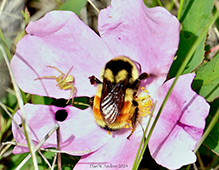 |
||
Bumble Bee & Northern Crab Spider... The bumble bee landed on the wild rose blossom and moved around while it fed and the crab spider got spooked and moved away from the bee. |
||
Northern Crab Spider with its lunch a... Yellow Jacket Wasp. I was surprised it could kill a wasp. Also it could just pick it up and lift it above its head and carry it up the lead plant. Strong little spider. Came across these two northern crab spiders at Frenchman’s Bluff SNA recently. I’ve never really been into spiders, but these small crab spider species are really interesting and some are nicely colored and quite cute since they are so small. They spook easy as they often scooted under the flower if I approached to suddenly. Even the one with the wasp. It moved and hid behind the lead plant blossoms. I had too slowly and quietly move around to see what it was and what it was doing. I photographed and filmed them since not much else was going on out there and they were interesting little spiders. … the wild rose blossom wasn’t very big either was the spider. |
||
 |
||
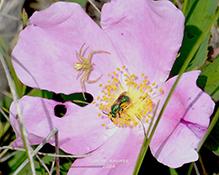 |
 |
|
… here is another Northern Crab with its dinner looks like some kind of a damsel fly or similar. That one was at the same area on 7-7-22. It is just a shrunk down 4k frame grab. |
||
Crab Spider and Metallic Green Bee... This crab spider was trying to sneak up on this small metallic green bee at Frenchman’s Bluff SNA Spring 2024. The bee seen the spider when it got right up to it and flew off. |
||
Alfredo Colon |
||
 |
 |
|
 |
 |
|
 |
 |
|
 |
 |
|
Dan Poretti |
 |
|
Mike Poeppe |
||
 |
 |
|
Margot Avey |
||
…I shot this picture of blood root and after taking the photo discovered there was some kind of a spider or insect on it with wicked looking legs. Could you tell me what kind it is? |
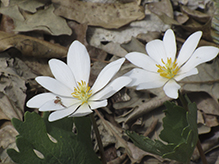 |
|
Spider and flower This photo was taken in St Paul Park, Minnesota by my friend Julie. She has given the okay to send it to you. Interesting flower and matching spider! We have no idea what kind of spider it is. |
 |
|
MinnesotaSeasons.com Photos |
||
|
||
|
||

Slideshows |
|

Visitor Videos |
||
Share your video of this arachnid. |
||
This button not working for you? |
||
Dan W. Andree |
"Northern Crab Spider vs Yellow Jacket Wasp" filmed by Dan W Andree |
About
The Northern Crab Spider is quite small maybe 1/4 in. body and maybe 1/2 in length legs. Something like that anyway. Harmless to humans and if I approached one suddenly it would scoot under the flower or plant it was on. So I had to move slow and quietly. I was surprised to see it captured a Yellow Jacket Wasp. Hope you enjoy this. |
Other Videos |
||
Northern Crab Spider catching and disposing of prey (Mecaphesa asperata) |
About
Oct 26, 2016 This beautiful spider should win an Academy Award. Arachnida (Arachnids) » Arachnids (Spiders) » Araneomorphae (Typical Spiders) » Entelegynes » Thomisidae (Crab Spiders) » Mecaphesa » Mecaphesa asperata (Northern Crab Spider) Music: Pina Colada |

Visitor Sightings |
||
Report a sighting of this arachnid. |
||
This button not working for you? |
||
| Dan W. Andree June 2024 |
Location: Frenchman’s Bluff SNA The bumble bee landed on the wild rose blossom and moved around while it fed and the crab spider got spooked and moved away from the bee. |
| Alfredo Colon 8/28/2022 |
Location: Albany, NY |
 |
| Alfredo Colon 8/26/2022 |
Location: Albany, NY |
 |
| Alfredo Colon 8/11/2022 |
Location: Albany, NY |
 |
| Alfredo Colon 8/4/2022 |
Location: Albany, NY |
 |
| Alfredo Colon 8/3/2022 |
Location: Albany, NY |
 |
| Dan Poretti 8/23/2022 |
Location: Milaca, MN |
 |
| Mike Poeppe 6/16/2022 |
Location: just west of Houston, MN |
 |
| Margot Avey 5/10/2022 |
Location: Big Willow Park, Minnetonka, Minnesota I shot this picture of blood root and after taking the photo discovered there was some kind of a spider or insect on it with wicked looking legs. Could you tell me what kind it is? |
MinnesotaSeasons.com Sightings |
||
|

Created: 8/16/2021 Last Updated: © MinnesotaSeasons.com. All rights reserved. |
